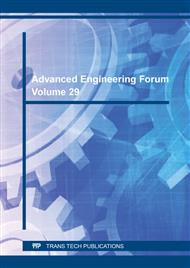[1]
T. Syversen, P. Kaur, The toxicology of mercury and its compounds. Journal of Trace Elements in Medicine and Biology. Society for Minerals and Trace Elements (GMS). 26 (2012) 215-226.
DOI: 10.1016/j.jtemb.2012.02.004
Google Scholar
[2]
United States Environmental Protection Agency, National Primary Drinking Water Regulations MCL booklet. EPA 816-F-09-004 (2009).
Google Scholar
[3]
Council Directive 98/83/EC of 3 November 1998 on the quality of water intended for human consumption as amended by Regulations 1882/2003/EC and 596/2009/EC.
DOI: 10.1017/cbo9780511610851.055
Google Scholar
[4]
M. J. Culzoni, A. Muñoz de la Peña, A. Machuca, H. C. Goicoechea, R. Babiano, Rhodamine and BODIPY chemodosimeters and chemosensors for the detection of Hg2+, based on fluorescence enhancement effects. Analytical Methods. 5 (2013) 30-49.
DOI: 10.1039/c2ay25769f
Google Scholar
[5]
M. H. Lee, S. J. Lee, J. H. Jung, H. Lim, J. S. Kim, Luminophore-immobilized mesoporous silica for selective Hg2+ sensing. Tetrahedron. 63 (2007) 12087-12092.
DOI: 10.1016/j.tet.2007.08.113
Google Scholar
[6]
J. Hu, C. Li, S. Liu, Hg2+-reactive double hydrophilic block copolymer assemblies as novel multifunctional fluorescent probes with improved performance. Langmuir. 26 (2010) 724-729.
DOI: 10.1021/la9024102
Google Scholar
[7]
H. Liu, P. Yu, D. Du, B. Qiu, X. Chen, G. Chen, Rhodamine-based ratiometric fluorescence sensing for the detection of mercury (II) in aqueous solution. Talanta. 81 (2010) 433-437.
DOI: 10.1016/j.talanta.2009.12.020
Google Scholar
[8]
H. N. Kim, W. X. Ren, J. S. Kim, J. Yoon, Fluorescent and colorimetric sensors for detection of lead, cadmium, and mercury ions. Chemical Society Reviews. 41 (2012) 3210-3244.
DOI: 10.1039/c1cs15245a
Google Scholar
[9]
H. Zheng, X.-Q. Zhan, Q.-N. Bian, X.-J. Zhang, Advances in modifying fluorescein and rhodamine fluorophores as fluorescent chemosensors. Chemical Communications. 49 (2013) 429.
DOI: 10.1039/c2cc35997a
Google Scholar
[10]
Y.-K. Yang, S.-K. Ko, I. Shin, J. Tae, Synthesis of a highly metal-selective rhodamine-based probe and its use for the in vivo monitoring of mercury. Nature Protocols. 2 (2007) 1740-1745.
DOI: 10.1038/nprot.2007.246
Google Scholar
[11]
D. Bohoyo Gil, M. I. Rodríguez-Cáceres, M. C. Hurtado-Sánchez, A. Muñoz de la Peña, Fluorescent determination of Hg2+ in water and fish samples using a chemodosimeter based in a Rhodamine 6G derivative and a portable fiber-optic spectrofluorimeter. Applied Spectroscopy. 64 (2010).
DOI: 10.1366/000370210791211600
Google Scholar
[12]
Y. K. Yang, K.-J. Yook, J. Tae, A Rhodamine-based fluorescent and colorimetric chemodosimeter for the rapid detection of Hg in aqueous media. Journal of the American Chemical Society. 127 (2005) 16760-16761.
DOI: 10.1021/ja054855t
Google Scholar
[13]
S.-K. Ko, Y.-K. Yang, J. Tae, I. Shin, In vivo monitoring of mercury ions using a Rhodamine-based molecular probe. Journal of the American Chemical Society. 128 (2006) 14150-14155.
DOI: 10.1021/ja065114a
Google Scholar
[14]
Y.-K. Yang, S.-K. Ko, I. Shin, J. Tae, Fluorescent detection of methylmercury by desulfurization reaction of rhodamine hydrazide derivatives. Organic and Biomolecular Chemistry. 7 (2009) 4590-4593.
DOI: 10.1039/b915723a
Google Scholar
[15]
V. A. Lozano, G. M. Escandar, M. C. Mahedero, A. Muñoz de la Peña, A novel nylon membrane-rhodamine 6G spirocyclic phenylthiosemicarbazide derivative system as a fluorimetric probe for mercury (II) ion. Analytical Methods. 4 (2012) 2002-(2008).
DOI: 10.1039/c2ay05850b
Google Scholar
[16]
F. J. Orriach-Fernández, A. Medina-Castillo, J. F. Fernández-Sánchez, A. Muñoz de la Peña, A. Fernández-Gutiérrez, Hg2+-selective sensing film based on the incorporation of a rhodamine 6G derivative into a novel hydrophilic water-insoluble copolymer. Analytical Methods. 5 (2013).
DOI: 10.1039/c3ay40717a
Google Scholar
[17]
F. J. Orriach-Fernández, A. L. Medina-Castillo, J. E. Diaz-Gómez, A. Muñoz de la Peña, J. F. Fernández-Sánchez, A. Fernández Gutiérrez, A sensing microfibre mat produced by electrospinning for the turn-on luminescence determination of Hg2+ in water samples. Sensors and Actuators B: Chemical. 195 (2014).
DOI: 10.1016/j.snb.2014.01.010
Google Scholar
[18]
R. Brasca, M. C. Onaindia, H. C. Goicoechea, A. Muñoz de la Peña, M. J. Culzoni, Highly selective and ultrasensitive turn-on luminescence chemosensor for mercury (II) determination based on the Rhodamine 6G derivative FC1 and Au nanoparticles. Sensors. 16 (2016).
DOI: 10.3390/s16101652
Google Scholar


